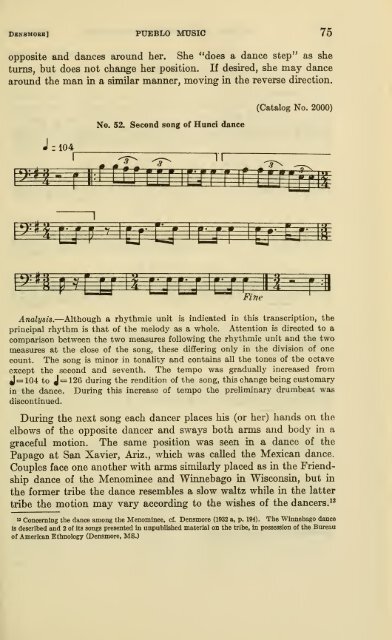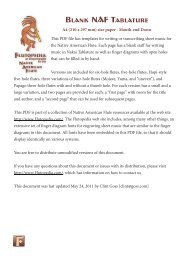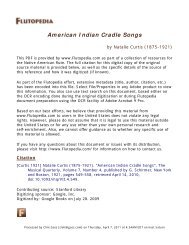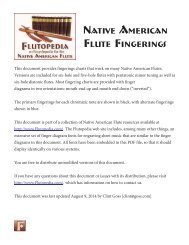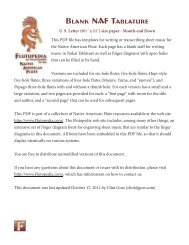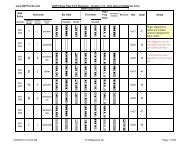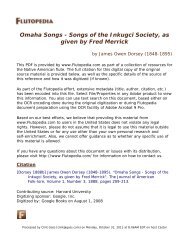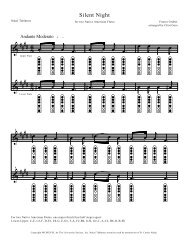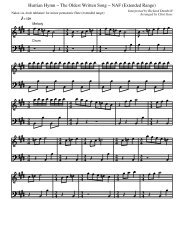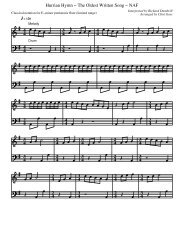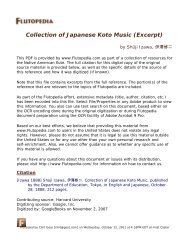Music of Acoma, Isleta, Cochiti, and Zuñi Pueblos - Flutopedia.com
Music of Acoma, Isleta, Cochiti, and Zuñi Pueblos - Flutopedia.com
Music of Acoma, Isleta, Cochiti, and Zuñi Pueblos - Flutopedia.com
You also want an ePaper? Increase the reach of your titles
YUMPU automatically turns print PDFs into web optimized ePapers that Google loves.
Dbnsmobb] PUEBLO MUSIC 75<br />
opposite <strong>and</strong> dances around her. She "does a dance step" as she<br />
turns, but does not change her position. If desired, she may dance<br />
around the man in a similar manner, moving in the reverse direction.<br />
(Catalog No. 2000)<br />
No. 52.<br />
Second song <strong>of</strong> Hunci dance<br />
J = 104<br />
V)--^'l- p<br />
| |<br />
:-^<br />
1T<br />
^-0- w-w~w m- m m m w-yrw<br />
'^'^'iU^ ^ ICJ-LJ<br />
I<br />
LTF<br />
I<br />
LT'-S<br />
Fine<br />
Analysis.—Although a rhythmic unit is indicated in this transcription, the<br />
principal rhythm is that <strong>of</strong> the melody as a whole. Attention is directed to a<br />
<strong>com</strong>parison between the two measures following the rhythmic unit <strong>and</strong> the two<br />
measures at the close <strong>of</strong> the song, these dififering only in the division <strong>of</strong> one<br />
count. The song is minor in tonality <strong>and</strong> contains all the tones <strong>of</strong> the octave<br />
except the second <strong>and</strong> seventh. The tempo was gradually increased from<br />
J=104 to J<br />
= 126 during the rendition <strong>of</strong> the song, this change being customary<br />
in the dance. During this increase <strong>of</strong> tempo the prehminary drumbeat was<br />
discontinued.<br />
During the next song each dancer places his (or her) h<strong>and</strong>s on the<br />
elbows <strong>of</strong> the opposite dancer <strong>and</strong> sways both arms <strong>and</strong> body in a<br />
graceful motion. The same position was seen in a dance <strong>of</strong> the<br />
Papago at San Xavier, Ariz., which was called the Mexican dance.<br />
Couples face one another with arms similarly placed as in the Friendship<br />
dance <strong>of</strong><br />
the Menominee <strong>and</strong> Winnebago in Wisconsin, but in<br />
the former tribe the dance resembles a slow waltz while in the latter<br />
tribe the motion may vary according to<br />
the wishes <strong>of</strong> the dancers.'^<br />
" Concerning the dance among the Menominee, cf. Densmore (1932 a, p. 194). The Winnebago dance<br />
Is described <strong>and</strong> 2 <strong>of</strong> its songs presented In unpublished material on the tribe, in possession <strong>of</strong> the Bureau<br />
<strong>of</strong> American Ethnology (Densmore, MS.)


